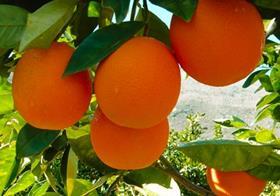
Southern Africa’s Citrus Marketing Forum (CMF) has issued its first forecast for the new season, which began in February with shipments of lemons, with the total volume from the region expected to reach 111.2m 15 kg cartons – 6 per cent down on last year.
“Whilst the drought that has gripped the country was expected by many to have a massive effect, the reality is that the real effects of the continued drought will only be seen in the 2017 export crop,” said the CMF in a circular to growers.
Valencias, the largest part of the crop and the one that dominates sales in the second part of the campaign, is expected to be 11 per cent down on last year. It is expected that 46.4m cartons of Valencias will be exported compared with 52.7m last year. It is the lowest Valencia crop in three years, dropping below 50m cartons for the first time since 2014.
The grapefruit crop will be nearly 23 per cent down, from 16.1m cartons last year to 12.4m this year. Navels, lemons and soft citrus will however increase compared to last year.
On 25.1m cartons Navels will increase by around half a million cartons, lemons will increase from 15.1m cartons last year to 16.1m this year, indicating the effect of new plantings which is caused by a buoyant lemon export market during the past three years. Soft citrus will increase from 10m cartons to 11.2m cartons.
The CMF says drought in the northern citrus growing areas of Limpopo Province and Mpumalanga has resulted in lower estimates for grapefruit and Valencia oranges, with expectations of smaller sized fruit than normal.
“The large Valencia orange and grapefruit producing region of Hoedspruit suffered the most with a massive hail storm adding to their drought woes. Their expected Valencia crop is down 36 per cent from the 3.3m cartons exported last year. Their grapefruit crop is expected to be 42 per cent lower.”
Prominent growers in the Limpopo region previously told Eurofruit that they had to make the agonising decision to cut irrigation to some of their orchards in order to save the others. This is where there could be long term damage, as the CMF indicated.
The CMF says that on the positive side, the dry conditions will result in sweeter fruit and generally quality is expected to be excellent.
While the grapefruit yields in the northern regions are suffering because of the drought, the CMF points out that these yields also tend to be cyclical. The effects of the drought are therefore exaggerated by this being an “off” year.
Grapefruit growers are reported to still be confident that they will be able to serve all the markets with the fruit available, although fruit may be half a count smaller. With oranges (Valencia’s and Navels together) in total being down by 7 per cent, grapefruit down 23 per cent, lemons up 7 per cent and soft citrus up 12 per cent, the CMF concluded that there is still a stable outlook and there are reasons for growers and exporters to be cautiously optimistic.






No comments yet